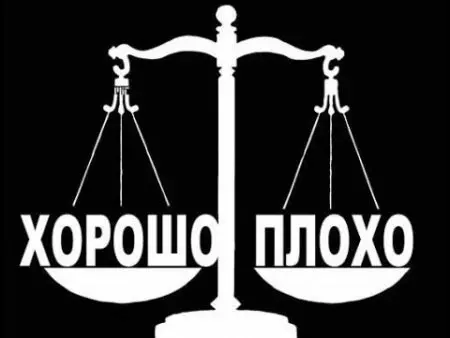The concepts of "ethics" and "etiquette" are pretty close, so many confuse these categories whose names are very similar. To avoid similar unpleasant missions, it should be understood that it is the subject of ethics, and what - etiquette, what is the difference and where these two spheres converge. To do this, first appeal to the origin and development of concepts and trace the stages of quality changes in their understanding.

What it is?
Both are an integral part of a social being, a generally accepted or unlawful form of regulating relations between people. The norms and rules of behavior in society, an understanding of responsibility for their actions and delimitation of the correct and incorrect is given to everyone since childhood.
In the process of growing and personality formation, some norms may be deformed or considered a person optional to execute. The problem lies in understanding which norms are a recommendatory nature, and for what lies hard taboo.

The origin of the concept of "ethics" is an ancient Greek, from the word Ethos, which means "temper, habit, custom". The first of him spoke the philosopher Aristotle, introducing a category in everyday life. He also allocated ethics into an independent section of practical philosophy, although initially her subject was slightly different from the modern understanding.

Around the era of the new time, the ethics was considered to be science about the soul and nature of man, the causes of his actions and how to achieve some perfect perfect state, that is, involved in the fields of psychology, anthropology, natural philosophy and social philosophy. Subsequently, ethics differed with adjacent disciplines and focused on its main subject - the study of morality and morality.
Ethics aims to resolve several major problems. First of all, it is a distinction between good and evil, the right and incorrect, permissible and unacceptable. Next, the question arises of dichotomy due and desired, that is, the problem of moral choice of man. And already from this it follows the need to figure out first with freedom of will, if it is inherent in whether a person is inherent initially or formed during the development process, and whether the individual is being controlled by the individual himself.
In a wider, universal sense, ethics accommodates in itself, including reflections on the meaning of life, the search for the purpose and the essence of the human being.


Moral and morality
The leading objects of the consideration of ethics as theoretical discipline are categories of morality and morality. This inseparable steam is still subject to disputes and discussions about their borders, entities and definitions. Currently generally accepted concept comes down to the following definitions:
- Morality (from Lat. Moralis, which means "concerning related to the businesses") is defined as a method of a regulatory, adopted in a certain society of the form of actions and behavior.
- Moral It is a more subjective concept and refers primarily to the method and norm of the internal self-regulation of an individual based on his free will.


Thus, it is obvious that The norm of morality is a social characteristic of a particular society and the same protected. You can talk about morality of different peoples and different social groups that sometimes differ straight apart from each other.
For morality, it is necessary to have a certain social institution that evaluates the behavior of its members and labeling it as a suitable or inappropriate.
Morality refers to the inner conviction of a person and is controlled by its exclusive conscience. In this case, the individual must achieve a certain level of self-consciousness, self-organization and responsibility for performing actions or inaction to determine for itself the boundaries of permissible and correct.

Etiquette
Despite the fact that the concept of "etiquette" was formed relatively recently (according to the standards of philosophical terms) - in the XVII century, in one form or another, the idea of it existed for all nations since the formation of ancient civilizations. A strict ceremonial was adopted in ancient China and Japan, generally accepted canons of behavior followed the ancient Greeks and Romans, even the semi-sidic nomadic peoples existed an internal hierarchy and a number of traditional rituals. At the time of the formation of absolutist monarchies in Europe, it was a wisdom of the court etiquette finally separated to know from the simple people.
Under the etiquette, the modern world is understood as a set of rules of conduct adopted in a specific society, which determines the boundaries of the permissible and unacceptable and regulating a certain sequence of actions in typical situations. These rules in most cases are more advisory, informal. However, with their non-compliance, the Company can apply to the violating different type of sanction ranging from lowering the interpersonal rating until complete rejection from the group.

Obviously, there are differences between the norms of etiquette of various nations, epochs, cultures and social groups. Several types can be selected conditionally:
- Business Etiquette;
- secular;
- professional;
- ceremonial;
- ritual;
- Situational.
All these species are interconnected, and the norms prescribed in them often echo.


General components
Of all the foregoing, it clearly follows that both disciplines define the norms and laws of social interaction, stabilize and regulate relations between people. Etiquette is often isolated as an independent subsection of applied ethics, that is, that part of which in the tasks of which the study of methods, the consequences and problems of the practical application of moral dogmas are included. Sometimes etiquette is called even "small ethics", wanting to emphasize the relationship existing among them.
At the heart of the rules of etiquette, in one form or another, the laws of the desired behavior developed by the Company are laid by the Company, contributing to a comfortable and pleasant solution to all parties to solve this or that situation.
The ultimate goal of etiquette is to create at least the visibility of a cultural, intelligent and conflict society. In a broad sense, all this regulations are based on the idea of the right, conscious, trustworthy individual, focused on productive and positive joint activities. And all these problems are the immediate field of ethical consideration.

Differences of concepts
Despite numerous similarities, the subject of ethics is much wider and viable. Many fundamental ethical issues, for example, good and evil in human nature, freedom of choice and responsibility for it, the problem of moral choice and personal conscience, completely alien etiquette. The main thing in the etiquette is a formal following the rules, rather, an external action, rather than the inner state of a person who committing it. The difference between the ethics in a more sensitive, deep attitude towards the human soul, its impulses, throwing and development.
Moreover, since the scope of the competence of ethics is global, then liability for violation of its norms is much tangible. If a person who has broken etiquette, consider, maximum, uneducated and non-ultimate, then who crossed the ethical boundary will call immoral, immoral or even inhuman. Some fundamental moral norms are so important for the very existence of society, which is prescribed in regulatory documents and are protected at the state level.

Norms and rules
The main rule of ethics, it is the golden rule of morality, known to everyone: "Turn to others as you want to treat you." In other words, Ethical attitude to the world should begin with the formation of the moral nucleus of the individual itself. The person is not moral, which is not able to distinguish the right from the wrong, shaking his interests for the sake of debt and justice, which is not able to be guided by the ideals of honor, dignity and conscience, is simply not able to become a moral carrier.
The ratio of morality and morality in ethics is inextricably linked with constant self-improvement, severe and regular internal work.
The rate of etiquette is manifested in the correct situational behavior, adequate and predictable for other participants in the interaction of the reaction. At the same time, the inner state of a person, his desire or reluctance, consent or protest against these norms is not taken into account. On compliance with the specific etiquette, both business and family, and friendly relations are based.

The norms of ethics and etiquette do not always coincide with each other. Violations of interpersonal regulations, non-compliance with the rules of behavior at the table, the use of inappropriate vocabulary and other minor inconsistencies of etiquette standards do not always come into conflict with the ethical nucleus of the individual. Mostly because they are too insignificant and fleeting. On the other hand, a person can consciously go to the violation of generally accepted standards of behavior, to do unpredictably and wrong, from the point of view of etiquette, wanting to emphasize his disagreement with it, to show a moral position.
About what good manners and why they are needed at all, see the following video.
